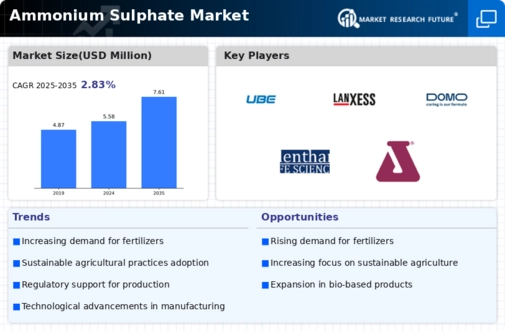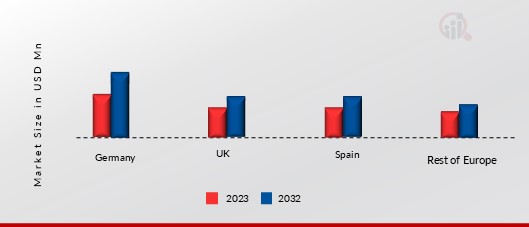RISING DEMAND FOR AMMONIUM SULPHATE IN FERTILIZERS
Once applied to soil, ammonium sulfate quickly dissolves into its ammonium and sulfate components. Plants can efficiently use both ammonium and nitrate forms of nitrogen for growth. In warmer soils, microbes initiate nitrification, converting ammonium into nitrate (2 NH₄⁺ + 3O₂ → 2NO₃⁻ + 2H₂O + 4H⁺). This process releases acidity (H⁺), gradually reducing soil pH with repeated applications. Ammonium sulfate's acidifying effect on the soil results from the nitrification process, not from the sulfate component, which has little impact on pH.
The potential for soil acidification with ammonium sulfate is higher than that of ammonium nitrate because all the nitrogen in ammonium sulfate converts to nitrate, compared to only half in ammonium nitrate.
The use of mineral fertilizers, particularly nitrogen (N) and phosphorus (P), plays a crucial role in the agricultural production. Fertilizer consumption is widespread across Europe, with arable crops dominating the fertilized area. According to Fertilizers Europe, the EU accounts for a relatively small share of global fertilizer production: only 9% of the nitrogen, 3% of the phosphate, and 8% of the potash worldwide are produced within the region. This creates a reliance on imports to meet agricultural demands. Fertilized areas across the EU show significant variation based on regional agricultural priorities.
In Western Europe (EU-14), 46% of the agricultural area is dedicated to arable crops, with cereals comprising 27%. Meanwhile, 19% of the area is grassland, and 9% is used for permanent crops such as vineyards and orchards. In contrast, the EU-13 countries of Central and Eastern Europe focus more heavily on arable production, with 70% of the agricultural land used for arable crops. This variance in agricultural practices drives the differing fertilizer requirements across the region.
Additionally, the need to maintain crop productivity on nutrient-deficient soils has significantly increased demand for fertilizers like ammonium sulfate, which offers both nitrogen and sulfur to support plant growth.
GROWING DEMAND FROM FOOD INDUSTRY
The rising demand for ammonium sulfate in the European food industry is largely driven by its extensive use across multiple food applications, particularly in bread, baked goods, winemaking, brewing, and sausage manufacturing. The food industry in Europe, is seeing an increased reliance on this compound due to its nitrogen content, which plays a critical role in food production processes. Bread is a daily staple across Europe, and the growing trend toward organic and artisanal bread has led to the increased use of ammonium sulfate in bread production.
Ammonium sulfate acts as a dough conditioner, improving the elasticity and consistency of bread dough, which results in superior texture and quality in the final product. As a stabilizer, it ensures the structural integrity of bread, allowing it to maintain its shape and softness for longer periods, which is essential for extending shelf life. This is particularly important in organic bread markets, such as Germany, France, and Italy, where consumers demand products that are not only healthier but also of premium quality.
The rising demand for ammonium sulfate in the European food industry is largely driven by its extensive use across multiple food applications, particularly in bread, baked goods, winemaking, brewing, and sausage manufacturing. The food industry in Europe, is seeing an increased reliance on this compound due to its nitrogen content, which plays a critical role in food production processes. Bread is a daily staple across Europe, and the growing trend toward organic and artisanal bread has led to the increased use of ammonium sulfate in bread production.
Ammonium sulfate acts as a dough conditioner, improving the elasticity and consistency of bread dough, which results in superior texture and quality in the final product. As a stabilizer, it ensures the structural integrity of bread, allowing it to maintain its shape and softness for longer periods, which is essential for extending shelf life. This is particularly important in organic bread markets, such as Germany, France, and Italy, where consumers demand products that are not only healthier but also of premium quality.
INCREASING USE IN PHARMACEUTICALS
The growing demand in the pharmaceutical industry is anticipated to significantly enhance growth opportunities in the European ammonium sulfate market. With projected revenues reaching US$196.50 billion in 2024, the pharmaceutical sector, particularly in Europe, is poised for substantial growth. This expansion is further underscored by the dominance of oncology drugs, which alone are expected to generate a market volume of US$34.26 billion in 2024. The projected compound annual growth rate (CAGR) of 4.53% from 2024 to 2029 indicates a promising trajectory, with market volume expected to soar to US$245.20 billion by 2029.
Ammonium sulfate, particularly in its NF granulated form, serves as a vital laboratory reagent and buffer, widely utilized in various biochemical and molecular biology applications. As a buffering agent, it maintains a stable pH in biochemical reactions, which is crucial for experiments involving enzymes and proteins, as even slight deviations in pH can lead to significant variations in activity and stability. Furthermore, ammonium sulfate's solubility properties facilitate its role in protein precipitation and fractionation. By altering the ionic strength of solutions, ammonium sulfate promotes the selective precipitation of proteins, aiding researchers in isolating specific proteins from complex mixtures.
This ability to precipitate proteins effectively is pivotal for proteomics studies, where understanding protein interactions and functions is essential. Additionally, in the context of high-throughput screening and drug discovery, ammonium sulfate aids in crystallization, an essential step for determining protein structures. The growing emphasis on research and development in biopharmaceuticals has fueled demand for high-quality reagents, positioning ammonium sulfate as a cornerstone in laboratories focused on drug development and protein research.

















Leave a Comment